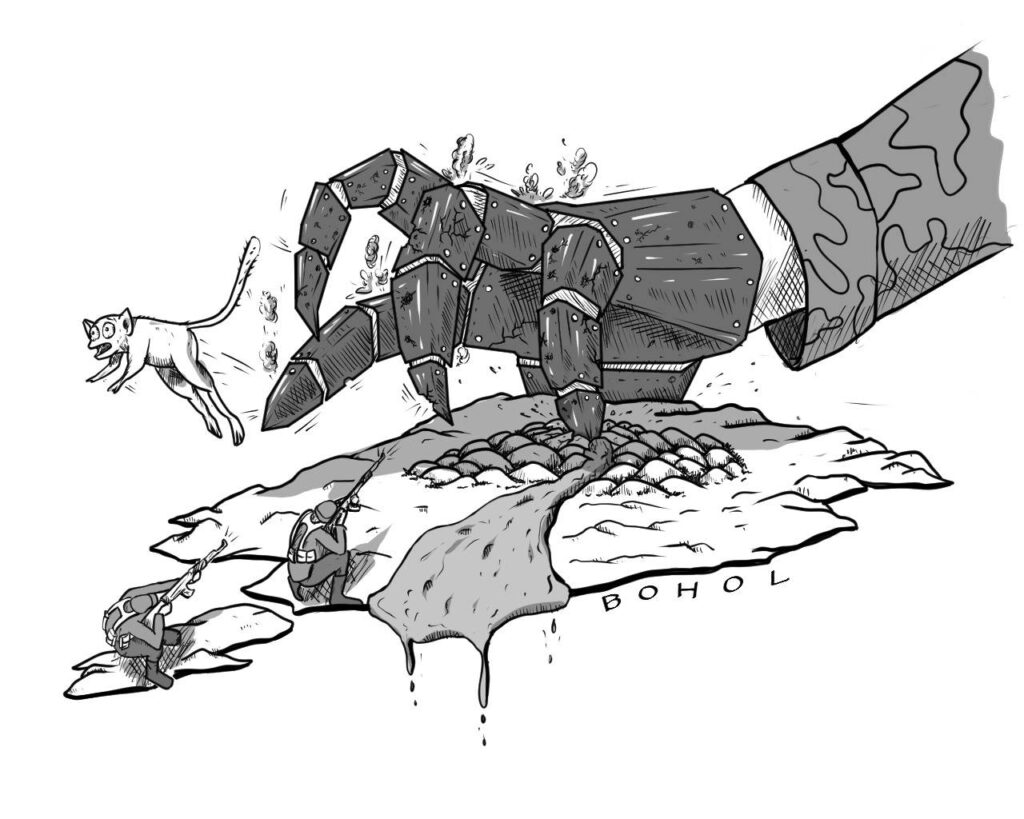
This article is available in PilipinoBisayaHiligaynon

March 07, 2024
The US-Marcos regime is mistaken in thinking that it could end the armed revolutionary resistance of the Bol-anon masses when it brazenly massacred five captured New People’s Army (NPA) Red fighters and Party cadres in Barangay Campagao, Bilar, Bohol on February 23. The martyrdom of the five, who served the interests of the peasant masses in Bohol and the Filipino people, is undeniably a great loss. However, their lives and sacrifices inspire further perseverance in the revolutionary struggle in the province.
Since taking root in the 1980s, the revolutionary movement in Bohol has never been completely defeated by the reactionary state. Despite the repeated declaration of the province as “insurgency-free”, the revolutionary fire in Bohol has never been extinguished. Amid continued oppression and exploitation, the revolutionary resistance on the island will never be vanquished.
Condition of the Bol-anon masses
The majority of the island’s 1.39 million people, especially the peasant masses, are suffering. Rice and corn, as well as coconut, banana, cassava, saba and oil palm are the main products.
Of the total 482,100 hectares of land in the province, 273,950 are agricultural, while 101,271 are forested. It is called the “food granary” of Central Visayas because of its large food production. As of 2018, rice fields account for 26% or 70,117 hectares of agricultural land. Only 56% of these have adequate irrigation.
Farmers now fear the damage that El Niño will bring to their rice fields. Tatay Boying, a farmer in the province, doesn’t know what to do with his farm due to the “dry spell” or abnormal rainfall conditions in Bohol.
“Irrigation is difficult because we only depend on rain…others have irrigation, but only a few benefit, then there is favoritism,” he said.
This is in stark contrast to the ₱7.1 million that the local Bohol government boasted of in November 2023 purportedly to help farmers and people affected by the drought. Apart from being meager, piles of requirements need to be met to receive benefits.
El Niño is expected to bring severe losses to Bohol farmers. Tatay Boying laments he already earns nothing from the usual harvest, how much worse now with the lack of irrigation.
His total expenses for each planting cycle is at least ₱11,000. He harvested 456 kilos or 12 sacks of palay, two of which will go the landlord for rent. If he sells it, he will get only ₱9,120 with palay farmgate prices at ₱24 per kilo. Because of the heavy loss, and with skyrocketing rice prices in the market, Tatay Boying chose to no longer sell his crop.
The greater calamity for the Bohol-anon masses is the intensified and widespread land grabbing by private corporations and landlords with the complicity of the local government. This includes the land grab by the Bohol Cattle Corporation (BCC), owned by a Marcos crony, of the 622 hectares of land, which the Trinidad-Talibon Integrated Farmers Association (TTIFA) has been fighting for. The BCC ignores the farmers’ documents in their drive to take over control of the 1,973 hectares it claims.
The oil palm plantations of the Philippine Agricultural Land and Mills Development Inc (PALM Inc), owned by the company AGUMIL Philippines, a partnership of Filipino and Malaysian investors, are also a burden on farmers. In 2012, at least 2,500 oil palm farmers went bankrupt as a result of the PALM Inc’s scheme to charge extremely high interest rates while driving down farmgate prices of their fruits. During this time, the company bought oil palm fruits from farmers for as little as ₱2/kilo. Because oil palm plantations used chemicals, farmers could no longer use the land. PALM Inc plantations covered 6,000 hectares of land.
Fishermen, who make up 33% of the province’s total population, are also mired in poverty. They suffer from constantly rising fuel, equipment and other costs. They also fear losing their livelihood due to the 650-hectare reclamation plan in Panglao Island, and the ongoing reclamation in Tagbilaran City.
The Bohol-anon masses cannot feel the local government’s claim of a 7.1% growth in the province’s gross domestic product in 2023, mainly from tourism. Despite money brought in by up to one million tourists annually, Bohol’s toiling masses remain miserable and hungry.
Meanwhile, when the Bol-anon masses do not die of hunger, they are killed and repressed by the military and police. In recent years, the Bol-anon masses who are fighting for land rights have faced relentless suppression. There are currently 10 political prisoners in Bohol including 75-year-old Adolfo Salas Sr, co-founder of the provincial chapter of the Kilusang Magbubukid ng Pilipinas na Hugpong sa mga Mag-uumang Bol-anon (HUMABOL-KMP). The 47th IB and the so-called Task Group Bohol of the Armed Forces of the Philippines and the Philippine National Police are the main agents of state terrorism in the province.
[Ang Bayan is the official news organ of the Communist Party of the Philippines and is issued by the CPP Central Committee. It provides news about the work of the Party as well as its analysis of and views on current issues. Ang Bayan comes out fortnightly and is published in Pilipino, Bisaya, Ilokano, Waray, Hiligaynon and English.]
https://philippinerevolution.nu/2024/03/07/bohols-land-is-fertile-for-advancing-the-revolution/

No comments:
Post a Comment
Note: Only a member of this blog may post a comment.